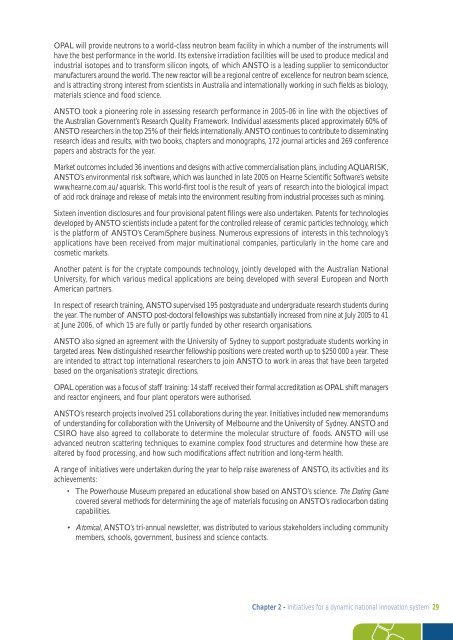The Australian Government's Innovation Report
The Australian Government's Innovation Report
The Australian Government's Innovation Report
Create successful ePaper yourself
Turn your PDF publications into a flip-book with our unique Google optimized e-Paper software.
OPAL will provide neutrons to a world-class neutron beam facility in which a number of the instruments will<br />
have the best performance in the world. Its extensive irradiation facilities will be used to produce medical and<br />
industrial isotopes and to transform silicon ingots, of which ANSTO is a leading supplier to semiconductor<br />
manufacturers around the world. <strong>The</strong> new reactor will be a regional centre of excellence for neutron beam science,<br />
and is attracting strong interest from scientists in Australia and internationally working in such fields as biology,<br />
materials science and food science.<br />
ANSTO took a pioneering role in assessing research performance in 2005-06 in line with the objectives of<br />
the <strong>Australian</strong> Government’s Research Quality Framework. Individual assessments placed approximately 60% of<br />
ANSTO researchers in the top 25% of their fields internationally. ANSTO continues to contribute to disseminating<br />
research ideas and results, with two books, chapters and monographs, 172 journal articles and 269 conference<br />
papers and abstracts for the year.<br />
Market outcomes included 36 inventions and designs with active commercialisation plans, including AQUARISK,<br />
ANSTO’s environmental risk software, which was launched in late 2005 on Hearne Scientific Software’s website<br />
www.hearne.com.au/aquarisk. This world-first tool is the result of years of research into the biological impact<br />
of acid rock drainage and release of metals into the environment resulting from industrial processes such as mining.<br />
Sixteen invention disclosures and four provisional patent filings were also undertaken. Patents for technologies<br />
developed by ANSTO scientists include a patent for the controlled release of ceramic particles technology, which<br />
is the platform of ANSTO’s CeramiSphere business. Numerous expressions of interests in this technology’s<br />
applications have been received from major multinational companies, particularly in the home care and<br />
cosmetic markets.<br />
Another patent is for the cryptate compounds technology, jointly developed with the <strong>Australian</strong> National<br />
University, for which various medical applications are being developed with several European and North<br />
American partners.<br />
In respect of research training, ANSTO supervised 195 postgraduate and undergraduate research students during<br />
the year. <strong>The</strong> number of ANSTO post-doctoral fellowships was substantially increased from nine at July 2005 to 41<br />
at June 2006, of which 15 are fully or partly funded by other research organisations.<br />
ANSTO also signed an agreement with the University of Sydney to support postgraduate students working in<br />
targeted areas. New distinguished researcher fellowship positions were created worth up to $250 000 a year. <strong>The</strong>se<br />
are intended to attract top international researchers to join ANSTO to work in areas that have been targeted<br />
based on the organisation’s strategic directions.<br />
OPAL operation was a focus of staff training: 14 staff received their formal accreditation as OPAL shift managers<br />
and reactor engineers, and four plant operators were authorised.<br />
ANSTO’s research projects involved 251 collaborations during the year. Initiatives included new memorandums<br />
of understanding for collaboration with the University of Melbourne and the University of Sydney. ANSTO and<br />
CSIRO have also agreed to collaborate to determine the molecular structure of foods. ANSTO will use<br />
advanced neutron scattering techniques to examine complex food structures and determine how these are<br />
altered by food processing, and how such modifications affect nutrition and long-term health.<br />
A range of initiatives were undertaken during the year to help raise awareness of ANSTO, its activities and its<br />
achievements:<br />
• <strong>The</strong> Powerhouse Museum prepared an educational show based on ANSTO’s science. <strong>The</strong> Dating Game<br />
covered several methods for determining the age of materials focusing on ANSTO’s radiocarbon dating<br />
capabilities.<br />
• Atomical, ANSTO’s tri-annual newsletter, was distributed to various stakeholders including community<br />
members, schools, government, business and science contacts.<br />
Chapter 2 - Initiatives for a dynamic national innovation system 29












![[Tam] Uygula[ya] - Bilim, Teknoloji ve Ä°novasyon Politikaları TartıÅma ...](https://img.yumpu.com/36820041/1/184x260/tam-uygulaya-bilim-teknoloji-ve-anovasyon-politikalara-tartaama-.jpg?quality=85)



